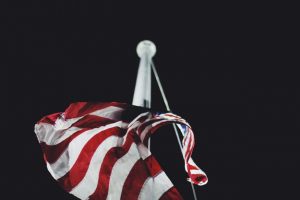The Waning Trust In Government
Jul 19th, 2025 | By Dr. Jim Eckman | Category: Featured Issues, Politics & Current EventsThe mission of Issues in Perspective is to provide thoughtful, historical and biblically-centered perspectives on current ethical and cultural issues.

It is now an axiom in 2025 American culture that America’s citizens do not trust their government; they have lost confidence in government and are skeptical of almost anything coming out of Washington or even state capitals. For a democracy to truly function well there must be a bond of trust between government and its citizens; a confidence that the state has its citizens’ best interests at heart. If there is an absence of trust, citizens will turn to someone or some form of government they can trust.
Anyone who studies American history knows that the relationship between the national government and its citizens has always been tenuous. Witness the decade of the 1850s before the Civil War (1861-1865). The Great Depression of the early 1930s exacerbated the lack of trust. Viet Nam and the Watergate scandal were devastating in terms of trust. Key presidents worked hard to restore trust in critical periods of our history (e.g., Abraham Lincoln, Franklin Roosevelt and Ronald Reagan).
But why is level of trust so low in 2025? There is no simple answer to this serious challenge, but a good place to start is Viet Nam. As The Economist recently observed, “The images of the fall of Saigon, on April 30th 1975, are indelible. A helicopter takes off from the roof of an apartment building, leaving behind a long line of would-be evacuees. Victorious North Vietnamese soldiers roll into the city in tanks, on their way to sack the United States embassy and raise their flag over the presidential palace. Vietnamese civilians rush onto packed boats in terror. America’s involvement in Vietnam began with realpolitik and ended in shame. It started covertly in 1954, soon after the Viet Minh, a nationalist, communist guerrilla group, terminated French colonial rule and Vietnam was cleaved in two. It grew into a war that killed almost 60,000 American soldiers and over 3m Vietnamese civilians and soldiers. America’s performance in the two world wars allowed the country to think of itself as benevolent and invincible. Vietnam put that myth to rest.”
In 1954 America was at peak self-confidence. The Second World War wreaked devastation, but America had emerged as a geopolitical and industrial power. The disturbances of the 1960s were still a decade ahead; the Depression’s privations were 15 years in the past. Polls taken in 1958 showed that 73% of Americans trusted their government to do the right thing. Meanwhile, America’s involvement in Vietnam was deepening. In 1960 America had 700 military “advisers” helping the pro-Western government of South Vietnam; by the end of 1964, that number had grown to 23,000. It was still too little. And so America began drafting young men to go to Vietnam.
Two things were notable about America’s military strategy. First, it was not working. In early 1965 McGeorge Bundy, the national security adviser, told President Lyndon Johnson that America could either negotiate a settlement between North and South Vietnam, or increase military pressure on the north. And second, it was largely kept from the public. In fact, as the war progressed in the late 1960s this much was clear: The US government was lying to the American public. And, in 1971 the Pentagon Papers, high-level government reports on the war, were leaked, revealing the depth of officials’ dishonesty about their motives and efficacy in Vietnam. A poll taken that year showed that 71% of Americans believed the war had been a “mistake.” By 1974 barely more than one-third of Americans trusted their government to do the right thing. Aside from a brief post-9/11 spike, America’s government has never regained the trust of a majority of its citizens. Today only 22% trust it, and it seems unlikely to win back Americans’ confidence soon.
A second strand of evidence that has depleted trust in government is the health of our presidents. FDR’s polio was not well known by the American people. JFK’s Addison’s disease was intentionally hidden. Most recently, the state of Joe Biden’s mental and physical health was the subject of a new book by Jake Tapper and Alex Thompson, entitled Original Sin: President Biden’s Decline, its Cover up and His Disastrous Choice to Run Again. The book reveals the following about his presidency: “that he never held a formal meeting to discuss whether to run for a second term; that he never heard directly from his own pollsters about his dismal public standing, or anything else; that by 2024 most of his own cabinet secretaries had no contact with him; that, when he was in Washington, he would often eat dinner at 4.30pm and vanish into his private quarters by 5.15; that when he traveled, he often skipped briefings while keeping a morning appointment with a makeup artist to cover his wrinkles and liver spots. You might think that Mr. Biden—that anyone—would welcome as a rationale that he had lost a step or two. It is a kinder explanation than the alternatives: vanity, hubris, incompetence.” This may not be merely a story of the decline of a man, his party and the media. It may turn out to be about the decline of American democracy itself.
Third is the disastrous state of the Democratic Party. Party leaders seem adrift and totally out of touch with what is occurring before their eyes. Columnist David Brooks puts all of this in historical context: “There have been only a few world-shifting political movements over the past century and a half: the totalitarian movement, which led to communist revolutions in places like Russia and China and fascist coups in places like Germany; the welfare state movement, which led in the U.S. to the New Deal; the liberation movement, which led, from the ’60s on, to anti-colonialism, the civil rights movement, feminism and the L.G.B.T.Q. movement; the market liberalism movement, which led to Ronald Reagan, Margaret Thatcher and, in their own contexts, Deng Xiaoping and Mikhail Gorbachev; and finally the global populist movement, which has led to Donald Trump, Viktor Orban, Brexit and, in their own contexts, Narendra Modi, Vladimir Putin and Xi Jinping. The global populist movement took off sometime in the early 2010s. It was driven by a comprehensive sense of social distrust, a firm conviction that the social systems of society were rigged, corrupted and malevolent. The Republicans have adjusted to the shift in the zeitgeist more effectively than the Democrats.”
Brooks continues: “For nearly a century, the Democrats have ridden on the grand narratives of previous eras. First, the welfare state narrative: America is too unequal; we can use big government to give people economic security. Second, the liberation narrative: History moves forward as progressive movements fight the oppression of marginalized groups: Black people, women, Palestinians, members of the L.G.B.T.Q. community. Those are noble narratives. They are not sufficient in the age of global populism. The Democrats’ first core challenge is that we live in an age that is hostile to institutions and Democrats dominate the institutions—the universities, the media, Hollywood, the foundations, the teachers unions, the Civil Service, etc. The second is that we live in an age in which a caste divide has opened up between the educated elite and everybody else, and Democrats are the party of the highly educated.”
Finally, I see in the national government an absence of political courage. Gerard Baker of the Wall Street Journal captures the essence of this certainty by giving focus to the One Big Beautiful Bill Act, the House’s attempt at implementing most of President Trump’s fiscal agenda. “The bill’s many defects have been well rehearsed: the fiscal incontinence that will see the addition of $3 trillion to the government’s $36 trillion in debt in the next 10 years; the failure to produce anything more than an exiguous reversal of the spending extravaganza of the past five years, with cuts of less than 2% of projected outlays over the next decade; the re-complexification of the tax code that the 2017 Tax Cuts and Jobs act had admirably simplified, with a smorgasbord of new deductions and exemptions; the reward for Democrat-run states’ profligacy represented by the quadrupling of the state and local tax deduction.”
He also argues that “All of this casts bigger doubt on the durability of America’s unique model of market-driven, innovation-led, private-sector-generated growth. We are witnessing all the signs of advancing economic derangement at the public-sector level: policy unpredictability, fiscal disorder and erratic interventionism on the shifting whims of a mercurial leader. This great republic is moving steadily up the steep curve of the banana.”
- We have a president who makes radical changes to tariffs based on economically dim views about international trade, who then changes and unilaterally changes them again with no notice or consultation, who believes he has the authority to tell companies like Walmart what they should be charging their customers and companies like Apple exactly where and how they should source their production, who seems intent on discouraging the brightest minds in the world from coming to the U.S., where they have contributed to America’s world-beating success in science, technology, innovation and entrepreneurship for decades.
- We have a Congress that unilaterally surrenders its constitutional responsibility over much of this policymaking and weighs in happily to compound the problem with politically expedient and economically reckless contributions of its own. And this after four years of a Democratic administration with a complaisant Congress that seized the opportunity presented by a dementia-disabled president to advance its own radical and economically ruinous goals.
The result of this incompetency? “In 2025 the value of the U.S. dollar has declined by almost 10% against other currencies. Since ‘Liberation Day,’ the interest rate investors demand to hold the safest of risk-free assets, 10-year U.S. government debt, has risen by half a percentage point to 4.5%. The spread between U.S. and German 10-year bond yields has increased by almost a full percentage point this year. This is a reflection of rising concern about U.S. fiscal sustainability as well as an attempt by markets to price the cost of policy uncertainty, capricious governing and instability.” For the past decade, American business has enhanced its advantage over the rest of the world, innovating in artificial intelligence, biotech and finance, boosting its productivity. Most of that has been achieved not because of policy but in spite of it. The US economic powerhouse constrained by erratic, unstable and obstructive government is in serious jeopardy.
See The Economist (26 April 2025), pp. 72-73; The Economist (24 May 2025), p. 24; David Brooks in the New York Times (6 June 2025); and Gerard Baker in the Wall Street Journal (27 May 2025).


